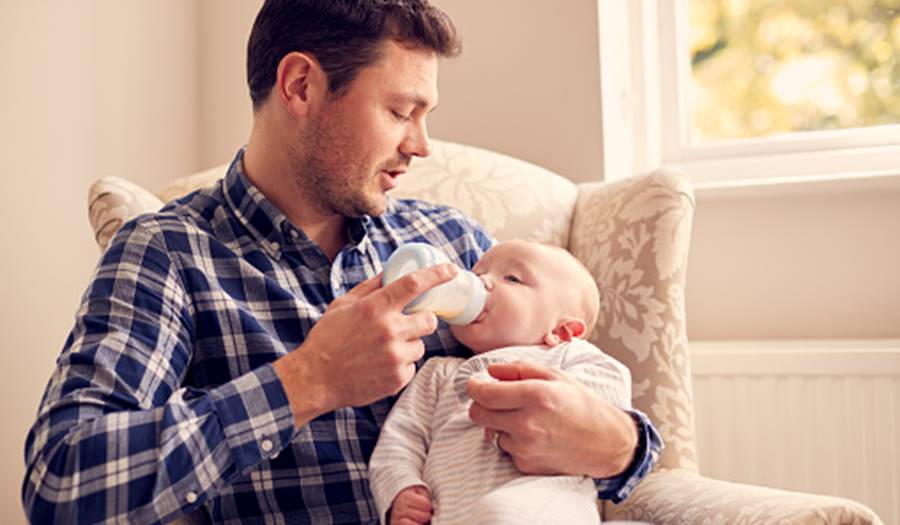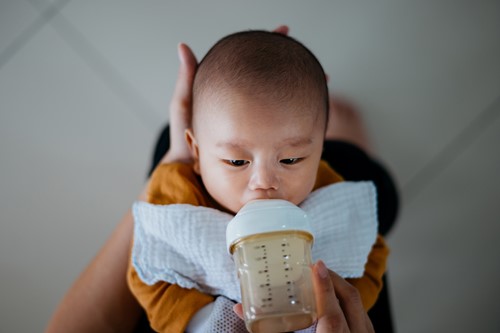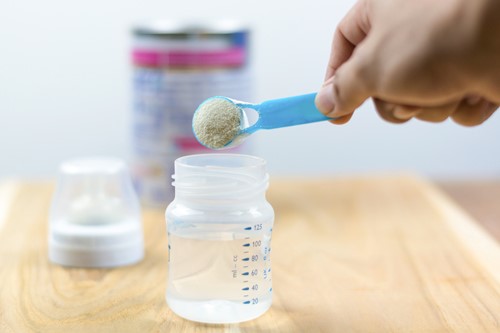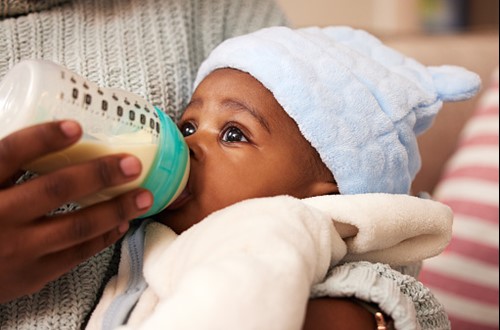
Formula Feeding
6/27/2022
FORMULA FEEDING
Formula is something that over 80% of families will use with their infant before the age of 1. There are many reasons a baby may be fed formula including personal preference, a parent returning to employment, breast feeding issues, adoption, surrogacy, allowing a partner or other caregiver to feed a baby, the physical health of the baby, the physical health of the mother, and the mental health of the mother. No matter WHAT the reason is, we all agree having a baby fed and thriving is always our number one goal. What is in formula? What types of formula are there? How do you prepare formula? What if you think your baby needs a different type of formula?
WHAT IS FORMULA?
Formula is an FDA-registered and monitored food for newborns and infants under 12 months of age. Formula is a mixture of carbohydrates, proteins, fats, vitamins, and minerals designed to provide infants nutrition to grow and develop. It is made to mimic the composition of human breast milk.
Formula and the FDA
The FDA has set standards that apply to formula sold in the United States. The formula must meet nutritional and safety standards. The nutritional quality standards include composition, nutrients, taste, aroma, and appearance. The safety is assessed for microscopic safety, chemical safety, and for allergens. The formula also is tested under different conditions to ensure safety being shipped and stored.
Only FDA registered formulas should be given to infants. Most European brand formulas, including many goat milk based formulas, are NOT registered with the FDA. Before the age of 1, only give your baby formula made for infants. Do not replace infant formula with toddler formula. Toddler formulas are NOT FDA-registered products, and do not need to uphold the nutritional and safety standards designed for infants’ needs. Infants should also not be given milk or a milk substitute before age 1 as there is not enough carbohydrate, fats, protein, vitamins or minerals, particularly iron, in these products. They also may not be easily digestible and may not be properly absorbed.
Generics
The FDA must also register generic formulas. There are no nutritional or safety differences between name brand and generic formula. When comparing labels, for example Nutramigen and the Target (Up and Up) brand of fully hydrolyzed formula, the nutrients and ingredient list are identical.
There are only 4 formula companies approved to manufacture infant formula in the United States. One company alone is responsible for almost all of the generics. If you buy a generic infant formula from one store, it is the same as a generic from another store. For example, if you buy the standard Target brand infant formula, the formula is the same exact standard infant formula sold at Walmart, CVS, Sam’s Club, Walgreens, Costco, RiteAid, and BJs.
Formula Myths
In some circles, formula is taboo or claimed to be unhealthy or “poison”. Formula is NOT poison. It is a life sustaining food that is the product of components from plants and animals. It provides nutrition, vitamins, and minerals to babies.
Formula is also believed to help babies sleep better. A recent National Institute for Health study found no causal relationship between formula and sleep.

TYPES
Cow’s Milk Formula
Cow’s Milk protein is 80% of all formula sold. Cow’s milk formulas use cow’s milk as a base. This is then adjusted and heated to make the milk safe and to mimic the nutrition provided by breast milk. Lactose is added to approximate the levels of lactose in human milk. The butterfat is removed and replaced with more easily digestible fats. Protein is broken down to help make it more digestible. Cow’s milk formulas also add vitamins, minerals, and additives such as DHAs and probiotics.
Cow’s milk formula generally has a 20:80 ratio of whey to casein whereas breast milk has a 60:40 ratio. The only cow’s milk formula that does NOT have this ratio are those made by Gerber. They use 100% whey protein and use only partially hydrolyzed proteins. This may make it more easily digestible for some babies.
Low Lactose Formulas
Low lactose formulas lower but don’t eliminate lactose in the formula. These formulas use other forms of sugar to increase the carbohydrates. These formulas are for babies who are unable to tolerate higher levels of lactose. This is actually rare in infants as the main carbohydrate in breast milk is lactose. Generally, most babies tolerate lactose well unless they have a specific metabolic condition preventing them from digesting lactose. Brand names include Earth Best Low Lactose, Baby’s Only LactoRelief, and Similac Pro-Sensitive.
Partially Hydrolyzed Formula
Partially hydrolyzed formulas use partially broken down protein chains to help a baby digest the food more easily. A baby who is gassy or suffers constipation or fussiness may benefit from a partially hydrolyzed formula. Brand names include Enfamil Gentlease and Similac Total Comfort. All Gerber formulas including Gerber Soothe and Gerber Gentle are partially hydrolyzed.
Fully Hydrolyzed Formulas
Fully hydrolyzed formulas use protein chains that have been fully broken down. These formulas are for babies that have cow’s milk protein allergy. Brands include Enfamil Nutramigen, Similac Alimentum, and Gerber Extensive HA.
Elemental Formula
Elemental formulas uses amino acids instead of protein chains. These formulas are dairy and lactose free. They may also use MCT oil as a more easily digestible fat source. Elemental formula is generally prescribed by a gastroenterologist. Brands include Neocate, Elecare, and Proamino.
Soy Formula
Soy formulas use soy protein and carbohydrates to mimic breast milk. Occasionally this formula will be used for an infant with cow’s milk protein allergy but because many of these babies also react to soy, it is usually avoided. It is used for infants with certain metabolic conditions (screened on the PKU test at birth) as well as by vegan families.
Anti-Reflux Formula
Anti-reflux formulas have rice cereal or a thickener added into the formula to ease reflux symptoms. The formula will be very thick and require a larger nipple size. Because of the thickening agents used, they cannot be used with infants on medications to treat reflux. Brands include Enfamil AR and Similac for Spit-Up.
A2 Protein Formula
A2 formulas are now being sold for babies with fussiness, gassiness, and constipation. They are made with A2 beta-casein. Cow’s milk protein is usually a combination of A1 and A2 type proteins but there are cows that only produce A2 proteins in their milk and this is the milk used in this formula. It is believed that A2 proteins are easier to digest. Brands include Similac Organic with A2, Gerber Gentle Supreme, and Enfamil A2.
Goat’s Milk Formula
No goat’s milk formulas have been cleared by the FDA for infant consumption. These are growing in popularity but we caution using these or having these shipped to you as they have not been identified for nutritional adequacy or safety.

HOW TO FORMULA FEED
Choosing Formula
The best formula is one that your baby tolerates and one that is affordable. There are 3 preparations of formula to choose from: Ready To Feed, Concentrated liquid, and Powdered.
Ready to Feed formula is a formula that has been premixed and comes needing no mixing, measuring or water. Ready to Feed formula generally comes in 2 ounce, 6 ounce, 8 ounce, or 1 quart packages. It is very convenient but very expensive.
Concentrated liquid is a liquid formula that must have water added to it. The recipe is the same no matter the brand. With concentrated liquid 2 ounces of concentrate is added to 2 ounces of water. Larger batches can be made and refrigerated for up to 48 hours. This preparation is convenient and more affordable than Ready to Feed but still pricey.
Powdered formula needs water to be added. The recipe is the same no matter the brand. One scoop of formula is added to 2 ounces of water. You can also make larger batches to be refrigerated and used for up to 24 hours. This is the most cost effective form of formula and is still considered convenient.
Preparing a Bottle
When preparing a bottle, you should make sure to wash your hands before beginning. Gather your water, bottle, and formula.
- WATER
- Water can be tap water, if determined safe by your local health department, or bottled water.
- If you are not comfortable with your tap water or it is not safe, you can boil it for 1 minute (no longer), let it cool for 30 minutes (no longer)
- BOTTLE
- Bottles should be clean
- Wash with soapy water and rinse well
- Bottles can be boiled for 5 minutes if desired
- Bottles may be placed in the dishwasher if allowed by the brand
- FORMULA
- Make sure the can is not dented as it can break the seal and allow bacteria to enter
- Make sure you use the scoop that comes with the formula can
- Make sure to follow the recipe exactly. If you are making a larger batch, double check your math
- 1 scoop in 2 ounces
- 2 scoops in 4 ounces
- 4 scoops in 8 ounces
- 8 scoops in 16 ounces
- 16 scoops in 32 ounces
When preparing a bottle, FIRST add water to the bottle, THEN add powder or concentrate. When making formula, the recipe MUST be followed exactly. Watering down formula can result in delays in growth, development, and electrolyte imbalances.
Formula bottles can be served at room temperature or warmed (but not hot) based on personal preference. Bottles should never be warmed in a microwave. Milk temperature should always be tested before giving to an infant to prevent burning or scalding.
For babies transitioning from human milk, they may need to have bottles warmed as they are used to warmer milk temperature. This can be slowly changed over time if you prefer serving bottles at room temperature.
Feeding A Bottle
When a baby is taking a bottle, they should be an active participant. They should open their mouth willingly and determine when the feed ends. If they empty a bottle and continue to smack their lips, or keep hands fisted by their face, they may be indicting they are still hungry. Offer more but in small amounts with frequent burping.
Bottle feeding should be done in 5-15 minutes. Prolonged bottle feeds can result in a baby burning more calories than they are taking in. If every bottle takes your baby longer than 15 minutes to finish, different bottles and nipple sizes should be tried. If changing nipple sizes doesn’t improve feeding, your child should be evaluated by their provider.
If our baby does not finish the bottle, any remaining formula must be thrown away 1 hour after serving it. If the bottle was untouched or unused, the prepared formula is good for 2 hours at room temperature or 24 hours if refrigerated. An open container of Ready to Feed or concentrated formula is good for 48 hour if refrigerated.
Bottle Propping
Do not prop a bottle up with a baby. A propped bottle is dangerous. Your baby cannot control the feeding or flow which increases the risk of choking. Propped bottles also increase the risk of tooth decay, ear infections, gassiness, and reflux.
Amount
A baby will only take a small amount of formula the first few days of life but after day 3-5, they will usually take 2-3 ounces (60-90ml) every 2-4 hours. And just like breastfed babies, they may have a period of the day, usually evening time, when they cluster feed meaning they take smaller, more frequent feeds over the course of 2-4 hours.
By 1 month most babies are taking 3-4 ounces per feed, every 3-4 hours. Every month babies increase 1 ounce per bottle until a max of 32-36 ounces a day. Generally at 6 months, babies will take 6 to 8 ounces bottles 4 to 5 times a day.
Transitioning off Breast Milk
When transitioning off breast milk, we recommend gradually transitioning or weaning. Replace one nursing session or expressed breast milk bottle with a formula bottle. We recommend a feeding session that has decreased production or emotional attachment or a session that is required by family schedule or preference.
Repeat this process every 3-7 days. If you are nursing, weaning any faster may result in clogged ducts, mastitis, breast abscesses, postpartum depression symptoms, or discomfort.
If your baby has taken an expressed breast milk bottle, replace it with the same amount of formula. Your baby may take less, the same amount, or want more. If you don’t know where to start, take their age in months and add 2 (up to 6 months) for a starting point, and adjust as your baby demands. For example, if they are 3 months, add 3 +2, so you would offer 5 ounces.
You may wean only a feed or two or wean completely to formula. This will be a personal choice. Your body and baby can adjust to any combination of feedings.

TROUBLESHOOTING
What if my baby seems gassy. Should I change their formula?
If your baby seems gassy or uncomfortable, try the following things before changing their formula. Changing formulas WILL result in several days to a week of digestive symptoms including gassiness, fussiness, and changes in stool before improvement.
If your baby is very gassy or uncomfortable, try the following:
- Paced Feeds
- Paced feeds help reduce air intake via the bottle and allows a baby to control the feed
- a reclined baby and a tilted bottle may result in more air and a fast, uncontrolled drip of formula
- How to do a paced feed
- Your baby should be held upright
- The bottle should parallel to the ground and level to the babies mouth
- Your baby should be actively drawing the milk out
- Stir the formula instead of shaking it as shaking creates more bubbles
- Check their latch on the bottle
- They should have their lips around the bottle
- You should not hear clicking noises
- They should not be leaking large amounts of milk
- Try other nipple types
- Try changing the position in which you burp them
- Hold them upright on your lap then tilt them forward
- Try holding them in a football hold on your forearm with their belly on your arm
- Try holding them across your lap with their belly on your lap
- Try an infant probiotic
- Try infant gas drops
- Use a venting bottle
If these tips do not work, then you can consider changing your baby’s formula. Just remember, any formula change will result in some digestive symptoms before your baby improves. We recommend trying a gentle or sensitive (partially hydrolyzed) formula if you are transitioning from standard infant formula.
My baby is straining to poop and turning red. Should I change their formula?
Babies are just starting to use their GI tract and gassiness, fussiness, and changing stools are normal especially for infants less than 2 months old. Babies who are formula-fed can have stools that are green, due to the iron in the formula, yellow and seedy, or brown. They can be liquid, pasty, or softly formed. They may occur every week or every feed. Straining, turning red, and grunting are normal parts of the stooling process for infants who need help increasing pressure in their abdomen in order to stool or pass gas. They should NOT be having small or hard stools. Stools should also not be black or red.
What if I think my baby has a cow’s milk protein allergy?
A cow’s milk protein allergy may present in the following ways
- Failure to gain weight or very slow weight gain
- Bloody stools
- Mucous in stools
- Severe colic
- Constipation
- Severe rash (not baby acne)
- Severe spitting or vomiting
If you suspect a cow’s milk allergy, please discuss with your provider. Do not change formula on your own. A true allergy will require a fully hydrolyzed or elemental formula. These formulas are VERY expensive and should only be used when medically necessary.
I can’t afford infant formula. What programs are available to help?
There are a number of programs to help you and your baby if you qualify for assistance.
WIC (the Special Supplemental Nutrition Program for Women, Infants, and Children) provides formula to babies. Information can be found HERE.
You can also use a SNAP (Supplemental Nutrition Assistance Program) to buy infant formula.
TANF (Temporary Assistance for Needy Families) provides temporary cash assistance that can be used to buy infant formula.
Feeding America has a list of local food banks that may also provide formula.
We are here as a partner in health for you and your family. However you choose to feed your baby whether exclusively breastfed, exclusively formula fed, or any combination in between, we support you and are here to answer any questions or concerns you may have.
Children’s Health Care of Newburyport, Massachusetts and Haverhill, Massachusetts is a pediatric healthcare practice providing care for families across the North Shore, Merrimack Valley, southern New Hampshire, and the Seacoast regions. The Children’s Health Care team includes pediatricians and pediatric nurse practitioners who provide comprehensive pediatric health care for children, including newborns, toddlers, school aged children, adolescents, and young adults. Our child-centered and family-focused approach covers preventative and urgent care, immunizations, and specialist referrals. Our services include an on-site pediatric nutritionist, special needs care coordinator, and social workers. We also have walk-in appointments available at all of our locations for acute sick visits. Please visit chcmass.com where you will find information about our pediatric doctors, nurse practitioners, as well as our hours and services.
Disclaimer: this health information is for educational purposes only. You, the reader, assume full responsibility for how you choose to use it.








